Physical Address
304 North Cardinal St.
Dorchester Center, MA 02124
Physical Address
304 North Cardinal St.
Dorchester Center, MA 02124
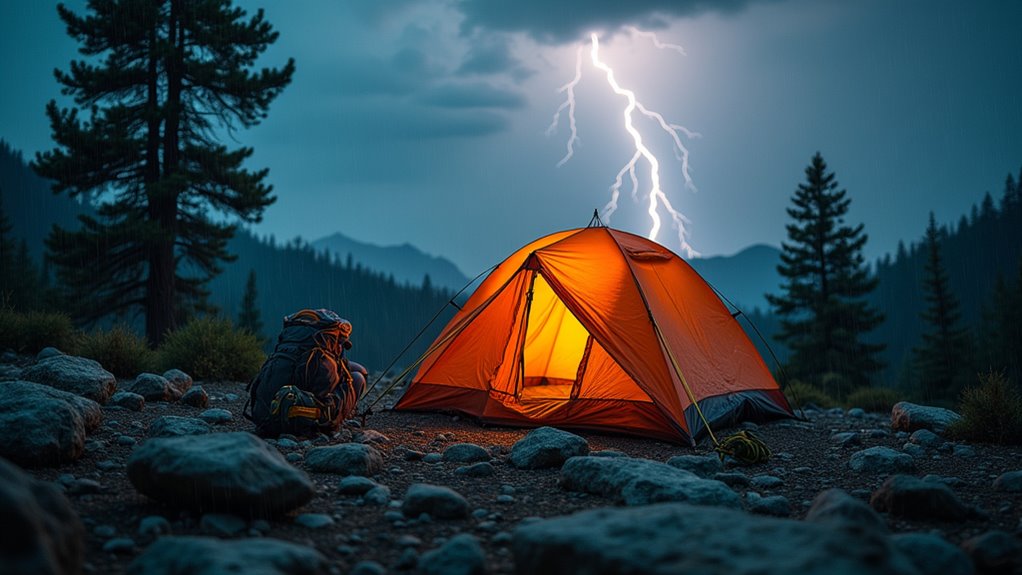
Protect yourself from dangerous lightning strikes while camping with these 13 crucial thunderstorm safety measures that could save your life.
Picture the sudden crack of lightning splitting the sky as your peaceful camping trip transforms into nature’s raw power display. You’re not helpless against thunderstorms – with the right knowledge, you can stay safe while still enjoying the outdoors. Whether you’re a seasoned camper or new to wilderness adventures, understanding these essential safety measures will give you the confidence to handle stormy weather. Let’s explore how you can protect yourself when Mother Nature releases her electric fury.
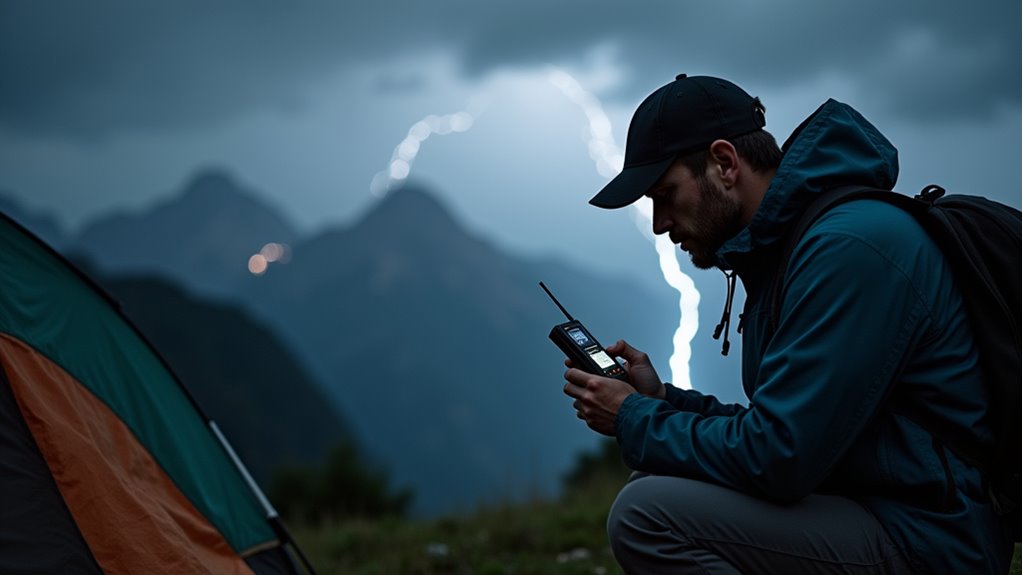
Before you pack your gear and head out, check multiple weather sources to get the most accurate forecast for your camping destination. Don’t rely on just one app or website—cross-reference National Weather Service forecasts with local meteorological services and weather radar maps. Pay special attention to afternoon and evening predictions, when thunderstorms typically develop.
Once you’re at your campsite, keep monitoring conditions throughout your stay. Download weather apps that work offline or bring a weather radio for remote areas without cell service. Watch the sky for telltale signs: darkening clouds, increasing wind, dropping temperatures, or that distinctive smell of rain approaching.
If severe weather‘s predicted within six hours of your location, start preparing your safety plan immediately rather than hoping the storm will pass by. When storms do pass, you’ll have plenty of time afterward to enjoy other fun activities that make camping memorable.
When you’re scouting for the perfect campsite, your location choice can mean the difference between riding out a storm safely and facing serious danger. You’ll want to avoid high ground, ridgetops, and exposed areas where you’d become a lightning target.
Instead, look for spots in valleys or lower elevations with natural windbreaks like dense trees or rock formations.
Stay away from lone tall trees, metal structures, and bodies of water. Don’t camp in dry creek beds or washes – they can become dangerous flash flood channels during storms.
Choose sites with good drainage so rainwater won’t pool around your tent.
If possible, find areas with a thick canopy of similarly-sized trees rather than isolated giants. This provides better protection while reducing lightning risk.
Just as you’d research travel insurance before an international trip, taking time to properly assess your campsite’s safety features before settling in can protect you from storm-related hazards.
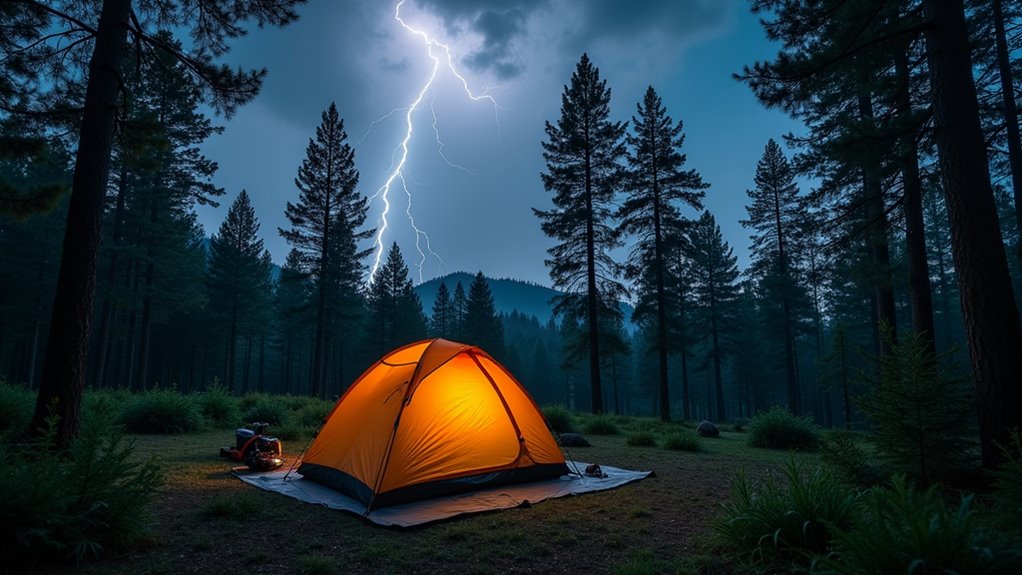
Once you’ve selected your campsite, creating a lightning-safe shelter becomes your next priority. Your tent placement and setup directly impact your safety during electrical storms.
Follow these essential shelter guidelines:
When making your campground reservation, consider using credit card payments as they often provide additional protection and dispute resolution options if weather conditions force you to cancel or modify your camping plans.
Beyond securing your shelter’s location, you’ll need to address the conductive materials around your campsite that can channel deadly electrical currents directly to you. Start by moving away from metal tent poles, cooking equipment, and hiking gear.
Don’t touch faucets, electrical outlets, or vehicle frames during lightning activity.
Remove jewelry like watches, rings, and necklaces—they’re excellent conductors.
Store metal camping chairs, tables, and grills at least 100 feet from your shelter.
Keep wet clothing and gear away from your body, as moisture dramatically increases conductivity.
If you’re caught in the open, avoid wire fences, metal railings, and power lines.
When camping near glacier climbing areas, be especially cautious of metal ice axes, crampons, and climbing hardware that can attract lightning strikes.
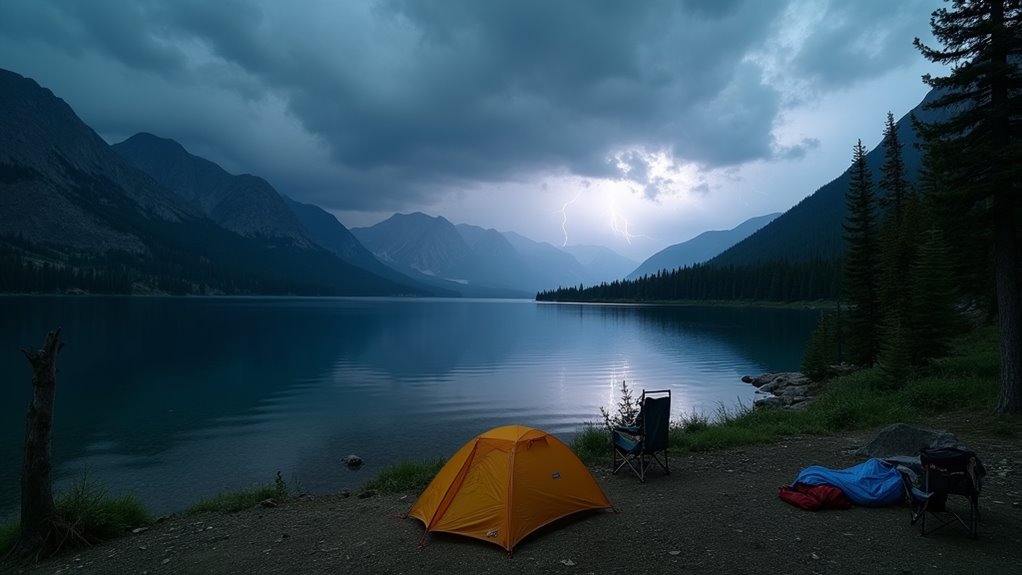
Water acts as a powerful conductor during thunderstorms, making lakes, rivers, and streams incredibly dangerous places to be. Lightning can travel through water for considerable distances, putting you at serious risk even if you’re not directly struck.
Here’s what you need to do when storms approach:
You’ll stay much safer by maintaining this distance until clear skies return. Plus, ensure your camping first aid kit is easily accessible and protected from rain, as storms can create hazardous conditions that increase the risk of injuries.
Knowing when to take cover becomes just as important as understanding where lightning poses the greatest threats. The 30-30 rule provides a simple method to gauge lightning danger during your camping trip.
When you see lightning, count the seconds until you hear thunder, then divide by five. If it’s 30 seconds or less, lightning’s within six miles—seek shelter immediately. Don’t wait for rain to start falling.
Stay sheltered for 30 minutes after hearing the last thunderclap. Many people make the mistake of emerging too early, but lightning can strike even after storms seem to pass.
This rule isn’t perfect, but it’s your best field assessment tool. Practice counting before your trip so you’ll react quickly when storms approach your campsite.
Just like deciding whether to rent or buy a boat for specific outdoor activities, choosing the right safety approach for your camping situation requires careful consideration of your specific needs and circumstances.
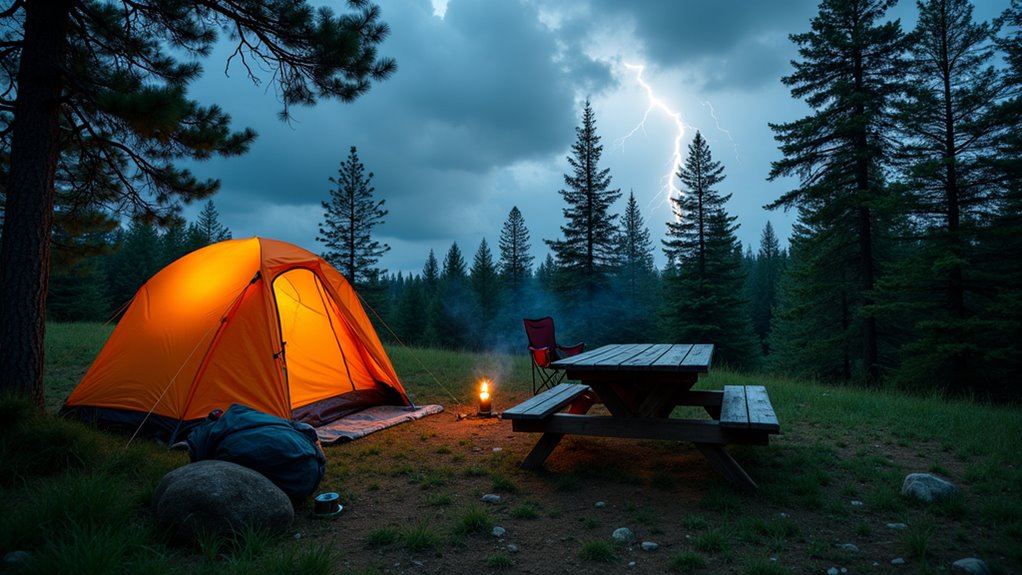
While you’re monitoring the skies for lightning, don’t forget that thunderstorms bring powerful winds that can turn your gear into dangerous projectiles. Securing everything isn’t just about protecting your belongings—it’s about preventing injuries from flying objects.
Thunderstorm winds transform camping gear into deadly projectiles—securing equipment protects both your belongings and prevents serious injuries from flying objects.
Here’s what you need to do immediately:
Don’t underestimate how quickly conditions can deteriorate. What seems like a gentle breeze can become dangerous gusts within minutes. Taking these steps early gives you peace of mind and keeps everyone safer.
If you’re camping in areas where insects are prevalent during storms, consider using mosquito nets as an additional protective barrier while sheltering in place.
Before you head into the wilderness, establish a clear communication plan that keeps you connected to the outside world during emergencies. Share your campsite location, arrival and departure times with trusted contacts back home. Program emergency numbers into your phone and consider carrying a satellite communicator or personal locator beacon for areas with poor cell coverage.
Download weather apps and enable emergency alerts on your devices. Designate specific check-in times with your emergency contact—if you miss a scheduled call, they’ll know to send help. Keep communication devices in waterproof cases and pack portable chargers or solar power banks.
Establish a backup meeting point if your group gets separated during severe weather. Clear communication protocols can mean the difference between a manageable situation and a dangerous emergency. Plus, pack an essential survival kit with emergency supplies that can sustain you if communication fails and rescue is delayed.

Since thunderstorms can develop rapidly and catch campers off guard, you’ll need specific gear that protects you from lightning, wind, and torrential rain. Your storm safety kit should complement your regular camping equipment with specialized items designed for severe weather conditions.
Essential storm safety equipment includes:
Don’t compromise on quality—your safety depends on reliable gear. Stay informed about the latest trends in camping safety equipment to ensure you have access to the most advanced storm protection gear available.
Flash floods pose one of the deadliest threats to campers because they can occur within minutes, even when storms are miles away upstream. You’ll need to act immediately when you hear flash flood warnings or notice rising water levels.
Never attempt to cross flowing water that’s above your ankles. Just six inches of moving water can knock you down, and two feet can sweep away vehicles.
If you’re camping near streams, rivers, or low-lying areas, move to higher ground immediately when warnings are issued.
Listen for the roar of approaching water and watch for debris floating downstream. Don’t wait to see the flood—by then it’s too late.
Your escape route should be planned before storms arrive, leading to elevated terrain at least 100 feet above nearby waterways.
If you’re caught in a flood while rock climbing, immediately abandon your climb and seek the highest possible ground, as wet rock surfaces become extremely slippery and dangerous.
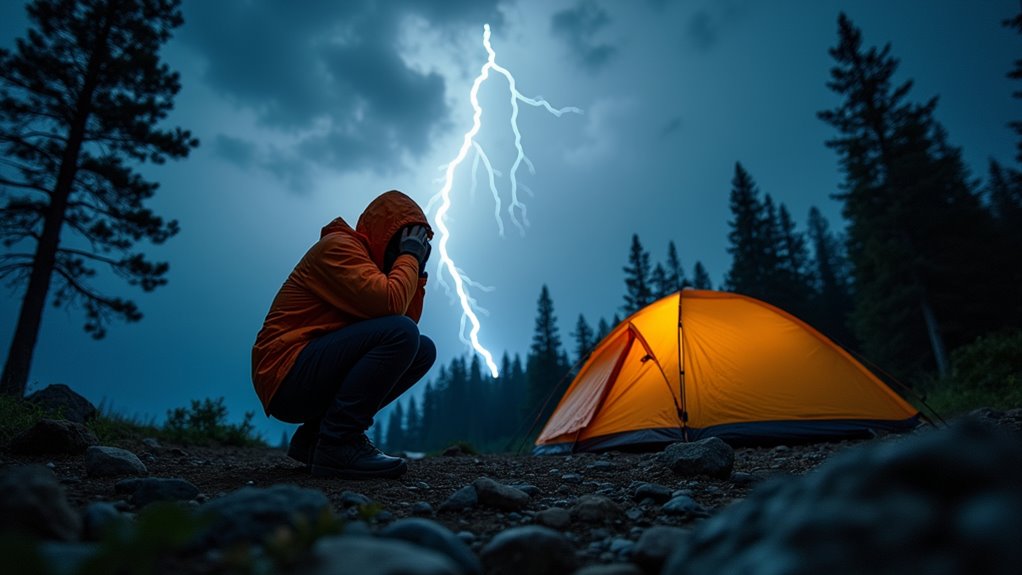
When lightning strikes within six miles of your campsite, you’ll need to find the safest possible position until the storm passes. Don’t panic – there are proven techniques that’ll keep you protected during active lightning.
Your positioning strategy should follow these essential steps:
These safety measures are especially crucial when family camping with children who may not understand the severity of lightning risks.
Why risk losing your essential communication lifelines when a few simple precautions can keep your devices safe during thunderstorms? First, unplug all devices from power sources immediately when lightning approaches.
Store electronics in waterproof containers or sealed plastic bags to prevent moisture damage. Keep your phone, GPS, and emergency radio in the center of your tent, away from metal tent poles and zippers.
Don’t charge devices during active storms, as power surges can destroy circuits permanently. If you’re using a portable generator, shut it down and disconnect everything.
Consider bringing surge protectors designed for camping, but remember they won’t stop direct lightning strikes. Keep backup batteries dry and separate from main devices.
When storm season ends, ensure proper winter storage of all electronic devices to prevent damage from cold temperatures and humidity during the off-season.
Your electronics are your emergency connection to help—protecting them protects you.
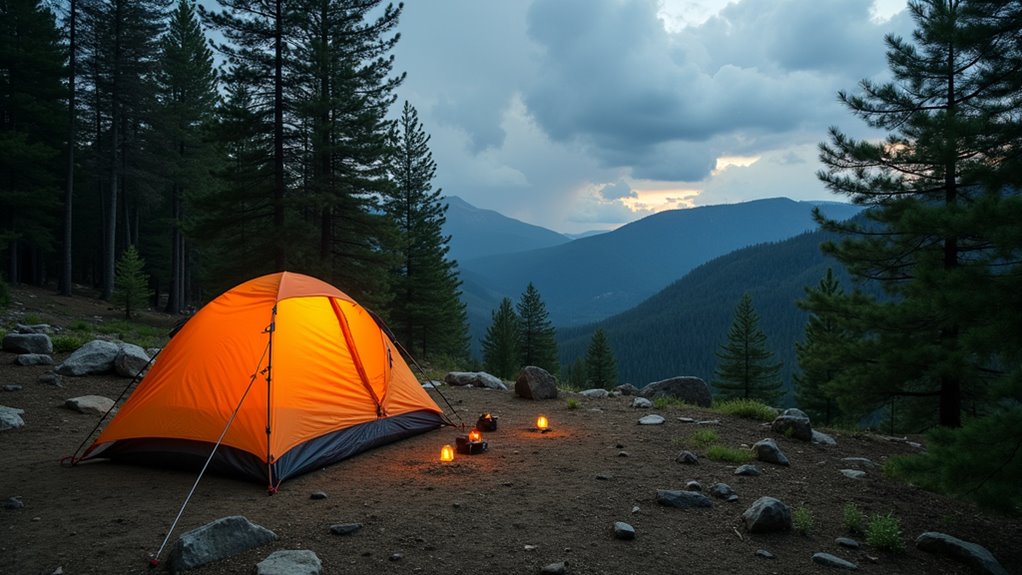
After the storm passes and silence replaces the thunder’s roar, you’ll need to systematically check your campsite for hazards before resuming normal activities.
Don’t rush this process – your safety depends on thorough inspection. Start by examining your immediate shelter area, then expand outward to assess the entire campsite.
Here’s your post-storm safety checklist:
Take your time with this assessment – it’s better to be cautious than sorry. Plus, be aware that storms can create dangerous conditions even in hot weather camping situations, so maintain vigilance regardless of temperature.
You’ve now got your safety toolkit to weather nature’s electrical tantrums. Remember, preparation isn’t just your best defense—it’s your lifeline when Mother Nature flexes her muscles. Don’t let fear keep you from enjoying the outdoors, but don’t let overconfidence put you in danger either. Stay alert, follow these guidelines, and you’ll turn potentially dangerous storms into just another part of your camping adventure. Your safety’s in your hands.